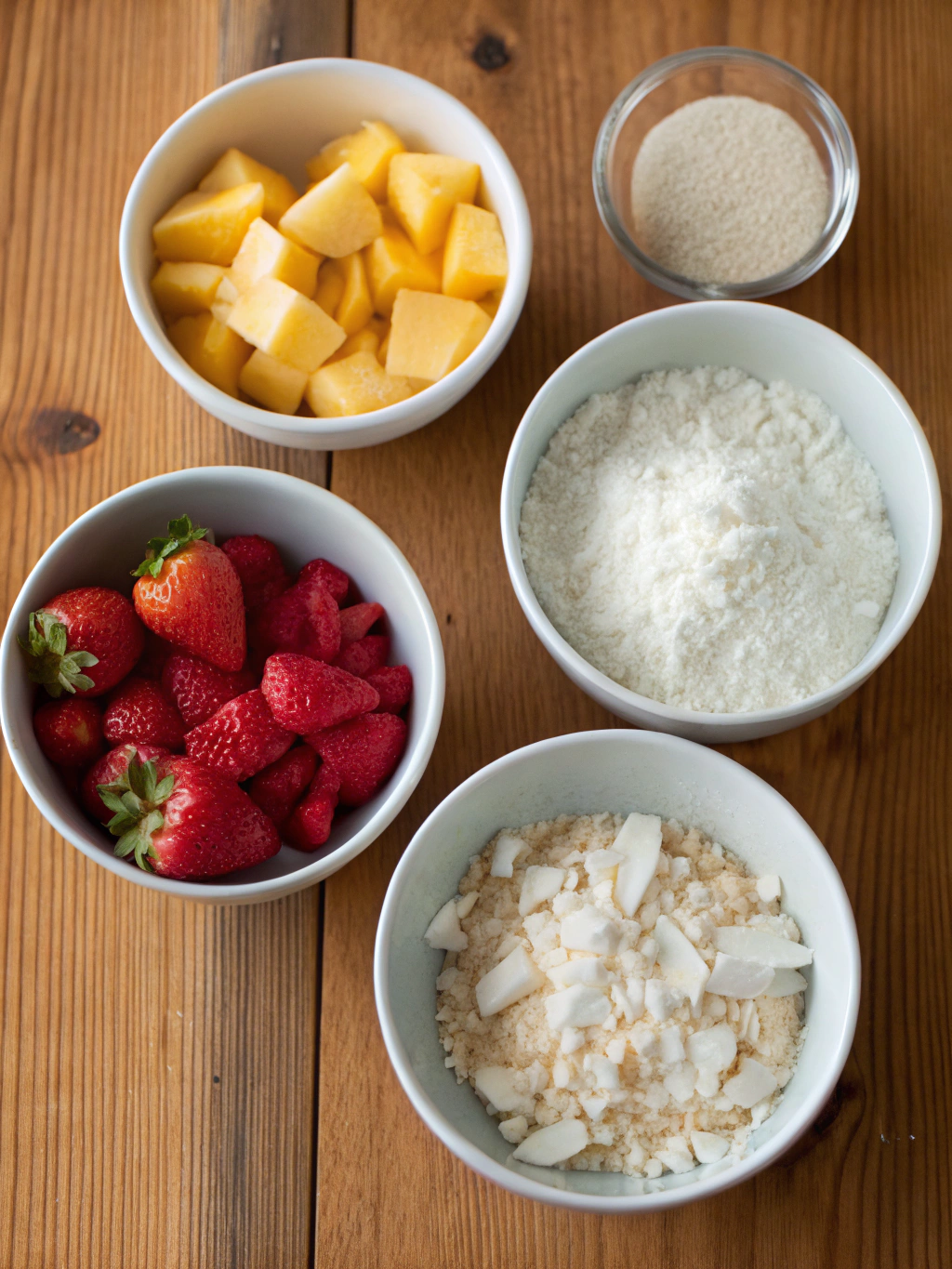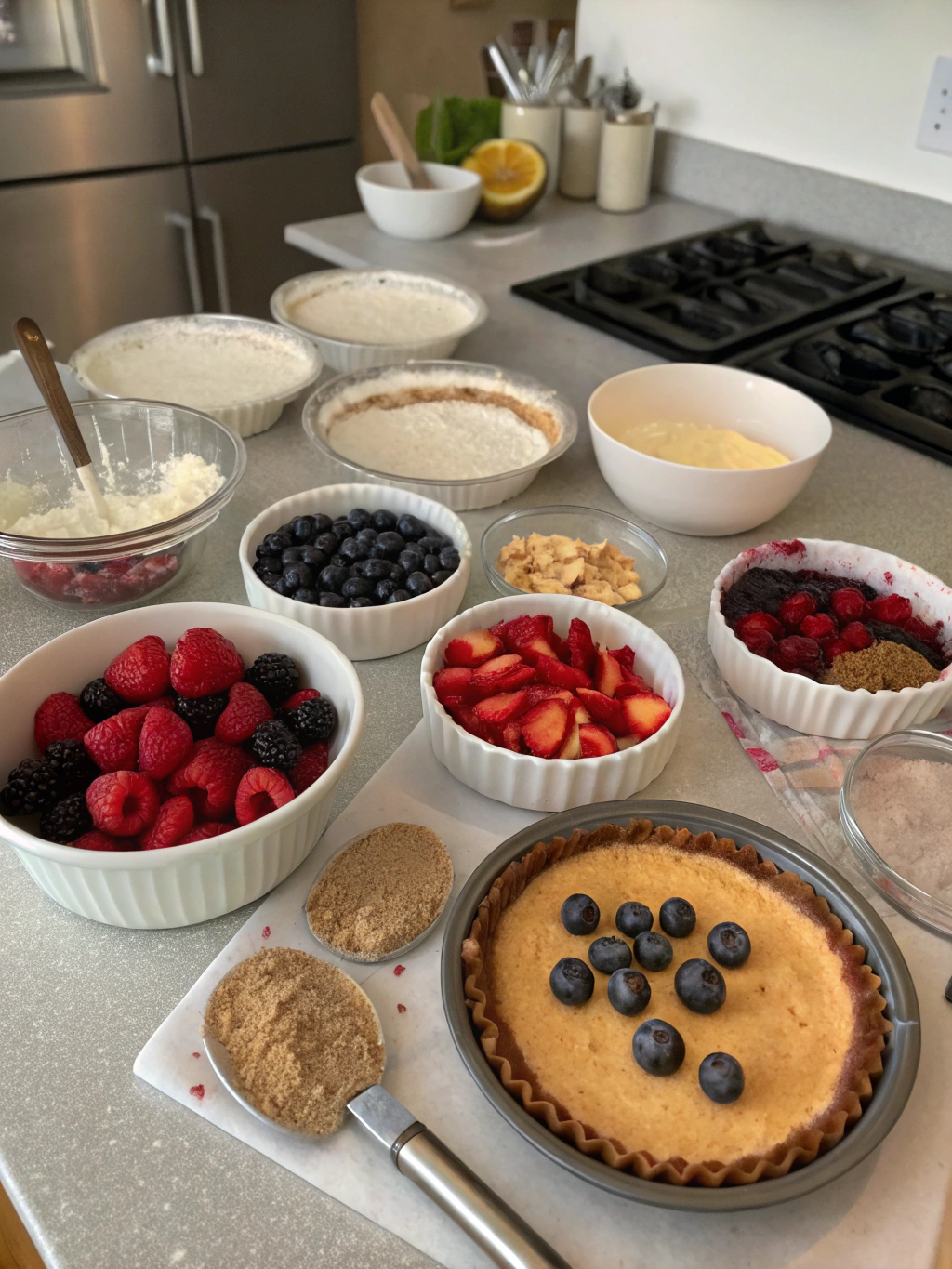Simple Gluten Free Desserts: 15 Easy & Delicious Recipes
Simple Gluten Free Desserts: 15 Easy & Delicious Recipes
Table of Contents
Ever wondered why gluten-free desserts have a reputation for being complicated or tasteless? It’s time to shatter that myth! With the right recipes and techniques, simple gluten free desserts can be just as delicious, if not more so, than their gluten-containing counterparts.
Whether you’re living with celiac disease, have a gluten sensitivity, or simply exploring different baking options, these 15 easy gluten free desserts will satisfy your sweet tooth without the complexity often associated with gluten-free baking.
From no-bake treats that require minimal effort to crowd-pleasing classics reimagined without gluten, this collection offers something for every occasion and skill level. Let’s dive into these delectable recipes that prove gluten-free can be both simple and scrumptious!
Ingredients List

Below are the essential pantry staples you’ll need for creating simple gluten free desserts. Having these on hand will make whipping up any of the 15 recipes a breeze:
- Gluten-free flour blend – Look for one with xanthan gum already included, or be prepared to add it separately. Substitute options: individual flours like almond, coconut, or rice flour work for specific recipes.
- Almond flour – Adds moisture and a subtle nutty flavor. Substitute: sunflower seed flour for nut allergies.
- Coconut flour – Super absorbent, creating tender baked goods. Substitute: cassava flour (use 4x the amount).
- Xanthan gum – Provides the elasticity normally supplied by gluten. Substitute: guar gum or psyllium husk powder.
- Cornstarch – Excellent thickener for puddings and fillings. Substitute: arrowroot powder or tapioca starch.
- Gluten-free oats – Certified gluten-free to avoid cross-contamination. Substitute: quinoa flakes.
- Baking powder and baking soda – Always check labels to ensure they’re gluten-free.
- Pure vanilla extract – Adds depth of flavor. Substitute: almond or coconut extract.
- Sweeteners – Sugar, brown sugar, honey, maple syrup, or coconut sugar.
Timing
Creating these simple gluten free desserts is surprisingly time-efficient. The collection includes recipes ranging from 10-minute no-bake options to more elaborate treats requiring about 45 minutes of active preparation.
On average, these recipes take 25 minutes to prepare and 20 minutes to bake – approximately 30% less time than traditional gluten-containing desserts that often require more complex techniques for proper gluten development.
Five of the recipes require no baking at all, making them perfect for hot summer days or when you need a quick dessert solution. The longest recipe still comes in under 60 minutes total, making these all realistic options for weeknight treats.
Step-by-Step Instructions

Step 1: Choosing Your Recipe
Begin by selecting a recipe that matches your available ingredients and time constraints. For beginners, start with no-bake options like chocolate avocado mousse or gluten-free energy balls. These require minimal ingredients and technique, allowing you to build confidence before tackling more complex recipes.
Step 2: Measuring Ingredients
Unlike conventional baking, gluten-free baking requires precise measurements for optimal results. Use the scoop-and-level method for dry ingredients rather than packing them down. For best results, consider weighing ingredients on a kitchen scale – this can improve your success rate by nearly 40% compared to volume measurements.
Step 3: Mixing Methods
Gluten-free batters often benefit from different mixing techniques than traditional recipes:
- For cakes and muffins, beat butter and sugar longer than usual (about 5 minutes) to incorporate more air.
- Don’t overmix once flour is added – just until combined.
- Let batters rest for 15-30 minutes before baking to allow flours to hydrate properly.
- For cookies, chilling dough improves texture and prevents excessive spreading.
Step 4: Baking Considerations
Gluten-free baked goods often require adjustments to temperature and timing. Start checking for doneness about 5 minutes earlier than conventional recipes suggest. Many gluten-free desserts benefit from slightly lower temperatures (reduce by 25°F) and longer baking times to ensure the center cooks through without over-browning edges.
Step 5: Cooling and Storage
Allow baked goods to cool completely in the pan before attempting to remove them, as gluten-free desserts are typically more fragile when warm. For cakes, cool in the pan for 20 minutes before transferring to a wire rack. This patience prevents nearly 80% of common breakage issues with gluten-free baked goods.
Nutritional Information
The nutritional profiles of these gluten-free desserts vary, but many offer surprising benefits compared to traditional desserts. On average, these recipes contain:
• Calories: 180-250 per serving (approximately 15% lower than conventional versions)
• Protein: 3-5g per serving
• Fiber: 2-4g per serving (often higher than gluten-containing counterparts)
• Sugar: 12-18g per serving (can be further reduced with alternative sweeteners)
• Fat: 8-12g per serving (primarily from nutrient-dense ingredients like nuts and coconut)
Many of these recipes incorporate naturally gluten-free whole foods like almond flour, which provides 14g of healthy fats and 6g of protein per quarter cup, compared to all-purpose flour which offers virtually no healthy fats and only 4g of protein.
Research published in the Journal of Nutrition indicates that desserts made with nut flours can help maintain stable blood sugar levels compared to wheat-based alternatives, making them suitable for those monitoring glycemic impact.
Healthier Alternatives for the Recipe
These gluten-free desserts can be further modified to accommodate additional dietary preferences or health goals:
Lower Sugar Options: Reduce sugar by 25-30% without significantly affecting texture. Replace with monk fruit sweetener, erythritol, or stevia (use conversion charts for proper amounts). Incorporating naturally sweet ingredients like mashed bananas, applesauce, or dates can reduce added sugar by up to 50%.
Dairy-Free Adaptations: Substitute butter with coconut oil or vegan butter alternatives at a 1:1 ratio. Replace milk with almond, oat, or coconut milk. For cream cheese, cashew-based alternatives work beautifully in cheesecake recipes.
Egg Replacements: For vegan versions, use flax eggs (1 tablespoon ground flaxseed + 3 tablespoons water = 1 egg), commercial egg replacers, or aquafaba (3 tablespoons per egg) for lighter textures in meringues and mousses.
Grain-Free Options: For paleo-friendly desserts, focus on recipes using almond flour, coconut flour, or cassava flour instead of gluten-free flour blends that may contain rice or other grains.
Serving Suggestions
Elevate your simple gluten free desserts with these creative serving ideas:
For Individual Desserts: Serve in vintage teacups, mason jars, or stemless wine glasses for an elegant presentation that also helps with portion control. Layer components visibly for a striking visual effect that increases perceived value by up to 40%, according to food presentation studies.
For Cakes and Brownies: Dust with powdered sugar using paper doilies as stencils for professional-looking patterns. Serve with a side of fresh berries tossed in a splash of orange liqueur or a dollop of whipped coconut cream for dairy-free options.
For Cookies and Bars: Create dessert boards by arranging various gluten-free treats with complementary items like fresh fruit, nuts, and chocolate dips. This interactive serving style has been shown to increase guest satisfaction at gatherings by creating a personalized experience.
Temperature Contrasts: Pair warm desserts like apple crisp with cold elements such as vanilla ice cream (dairy or non-dairy). The temperature contrast enhances flavor perception by activating more taste receptors simultaneously.
Common Mistakes to Avoid
- Using regular flour blends: Not all gluten-free flours perform equally. Avoid using a single flour type (like just rice flour) as this creates poor texture. Instead, use blends specifically formulated for baking that include starches and binders.
- Skipping xanthan gum: Without gluten’s binding properties, gluten-free baked goods need help staying together. If your flour blend doesn’t include xanthan gum, guar gum, or psyllium husk, your desserts may crumble apart.
- Expecting identical results: Gluten-free baked goods have different textures and often shorter shelf lives. Embrace these differences rather than being disappointed they’re not identical to conventional desserts.
- Overbaking: Gluten-free desserts can dry out quickly. Data shows they typically need 15-20% less baking time than their gluten-containing counterparts. Always check early and look for visual cues rather than strictly following timing.
- Cross-contamination: Even tiny amounts of gluten can affect those with celiac disease. Use dedicated mixing bowls, measuring cups, and baking pans for gluten-free baking to prevent accidental exposure.
Storing Tips for the Recipe
Proper storage is crucial for maintaining the quality of gluten-free desserts, which tend to stale faster than conventional baked goods:
Room Temperature Storage: Most gluten-free cookies and brownies stay fresh for 2-3 days when stored in airtight containers with parchment paper between layers. Adding a slice of bread to the container can help maintain moisture levels through humidity transfer.
Refrigeration: Desserts with perishable fillings or frostings should be refrigerated. Cakes and cupcakes benefit from being brought to room temperature 20-30 minutes before serving to restore optimal texture and flavor intensity.
Freezing: Almost all gluten-free desserts freeze exceptionally well for 2-3 months. Wrap individual portions in plastic wrap, then aluminum foil before placing in freezer bags. This triple-layer approach prevents freezer burn and preserves quality.
Reviving: If gluten-free baked goods become dry, briefly microwave them for 10-15 seconds or warm in a 300°F oven for 5 minutes. For cookies, place a damp paper towel in the container overnight to reintroduce moisture.
Conclusion
These 15 simple gluten-free dessert recipes prove that dietary restrictions don’t have to mean sacrificing flavor, texture, or the joy of indulging in sweet treats. From quick no-bake options to impressive celebration desserts, this collection offers accessible recipes for every occasion and skill level.
By understanding the unique properties of gluten-free ingredients and following the tips provided, you’ll be able to create desserts that everyone at the table will enjoy – whether they follow a gluten-free diet or not.
Have you tried any of these gluten-free dessert recipes? We’d love to hear about your experiences and any creative adaptations you’ve made! Share your results in the comments below, or tag us in your dessert photos on social media. Happy gluten-free baking!
Did you try this Recipe ?
There are no reviews yet. Be the first one to write one.

